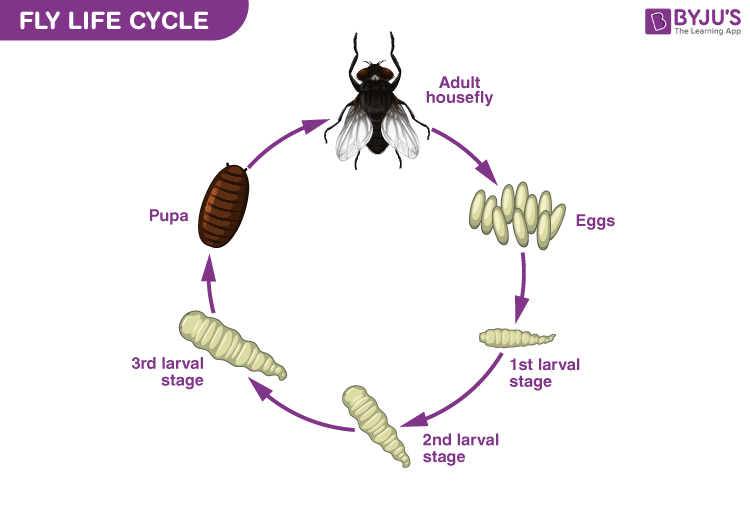Table of Contents
- Introduction
- Life cycle of a Fly
- The Egg Stage 1
- The Larvae Stage 2
- The Pupa Stage 3
- The Adult Stage 4
- Significance of flies
- Conclusion
Introduction
Flies are a group of large numbers of insects that fall under the order Diptera and the class Insecta. The insects that belong to the order Diptera (di – two, ptera-wings) are called ‘true’ flies. They have only one pair of wings, and the other pair is modified into a structure called Halteres. It has many important species of insects like mosquito, house fly, Tsetse fly, fruit fly, crane fly, black fly and flesh fly. Some flies like mayfly, dragonfly and butterflies are not considered as true flies and they do not belong to Diptera. By convention, only for true flies a space is added before the word fly.
E.g.: House fly – space between house and fly.
Mayfly – Not a true fly as it belong to order Ephemeroptera; No space given between may and fly.
Life cycle of a Fly
The order Diptera follows complete metamorphosis (holometabolous). That is their life cycle comprises four stages namely, egg, larva, pupa and adult.
After fertilization, the female adult flies, lay their eggs in clusters. A female fly can lay up to 300 eggs in one day. The eggs can take from eight to 20 hours to hatch, after which they enter the larval stage.
When the eggs hatch, the emerged larvae can also be referred to as maggots. During this stage, the larvae undergo several changes as they grow rapidly. There are three phases or instars in the larval stage. The larvae moult several times by shedding layers of their skin, before each instar stage. Initially, the larvae feed on fluid released from the body.
In their first instar, the larvae measure up to 5 mm in length before shedding their skin. In their second instar, the larvae measure up to 10 mm in length. By the time they reach their third instar, the larvae measure from 15 mm to 20 mm in length.
The time difference between each stage varies; in warmer temperatures, it takes about 3 days and in colder temperatures, it takes eight weeks.
With each moulting and instar stage passing, the larva grows bigger and reaches the pupa stage.
In this stage, the white colourless maggots or larvae develop and look similar to adult flies. The pupa looks for a suitable location for this developing stage. During this stage, the pupa fly does not feed and remains stationary.
The pupa is protected via the last, hard larval skin, which encloses the pupa known as the puparium. Under warm temperatures, the pupa takes about four to six days to transform into an adult fly.
During this stage, the adult fly emerges from the puparium and is ready to mate. The adult flies are sexually mature and begin the process of mating. Here, the adult fly feeds on the proteins released from body fluids. Unlike the pupa stage where the fly is stationary, when the fly transforms into an adult, they fly to different locations in search of food. After they are done feeding, they mate and eventually search for a suitable spot to lay eggs. The entire process then starts all over again.
Significance of flies
1. Mosquitoes are important insects that act as vectors for various diseases like dengue, chikungunya, malaria and elephantiasis.
2. Fruit flies are important pests in agriculture that are responsible for the degradation of fruit quality in horticulture crops.
3. The fruit fly Drosophila melanogaster is used for genetics experiments.
4. Tsetse fly is the vector for the disease sleeping sickness.
5. House flies act as mechanical carriers for various food-borne diseases.

Conclusion
In general, flies are despised by others due to their constant “buzzing” sound or when they circulate continuously around your food. Different species of flies are drawn to different food sources and therefore the flies fall for different baits. Flies are involved in spreading various diseases and hence learning their life cycle is important to escape from the diseases.
Frequently Asked Questions on Fly Life Cycle
Do flies fly in a pattern?
Flies do not follow a strict pattern of flight, but when they fly inside a house, they turn in corners. This is because flies cannot move their wings at different speeds.
Why do flies fly around human beings?
Flies look upon us as a constant source of food. Dead skin cells, oil, and salt are delicious food sources for flies.
Where do flies go during the night?
Flies usually sleep during the night and tend to take short power naps during the day. Flies can sleep on any surface like floors, walls, curtains and so on.
Why do flies rub their hands?
When flies are stationary on a surface, the flies rub their hands in order to clean themselves, before they fly again in search of food and watch out for predators.
How long does a fly infestation last?
If a household fly infestation is not treated, the flies can live for days, maybe even months. Flies lay eggs in a moist, decaying matter like garbage, glass clippings or faeces. Although this varies and depends on the species of flies. For example, the life expectancy of mayflies is 24 hours.
To explore more information on flies and other insects, register with BYJU’S Biology.


Comments